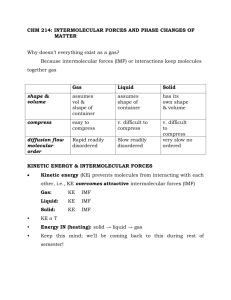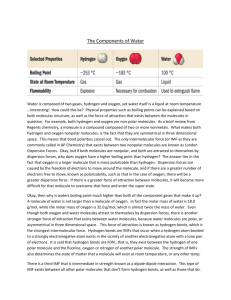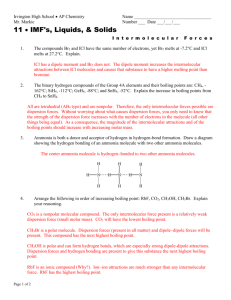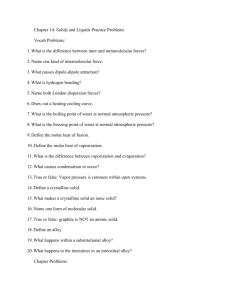Chem 2 AP HW 11
advertisement
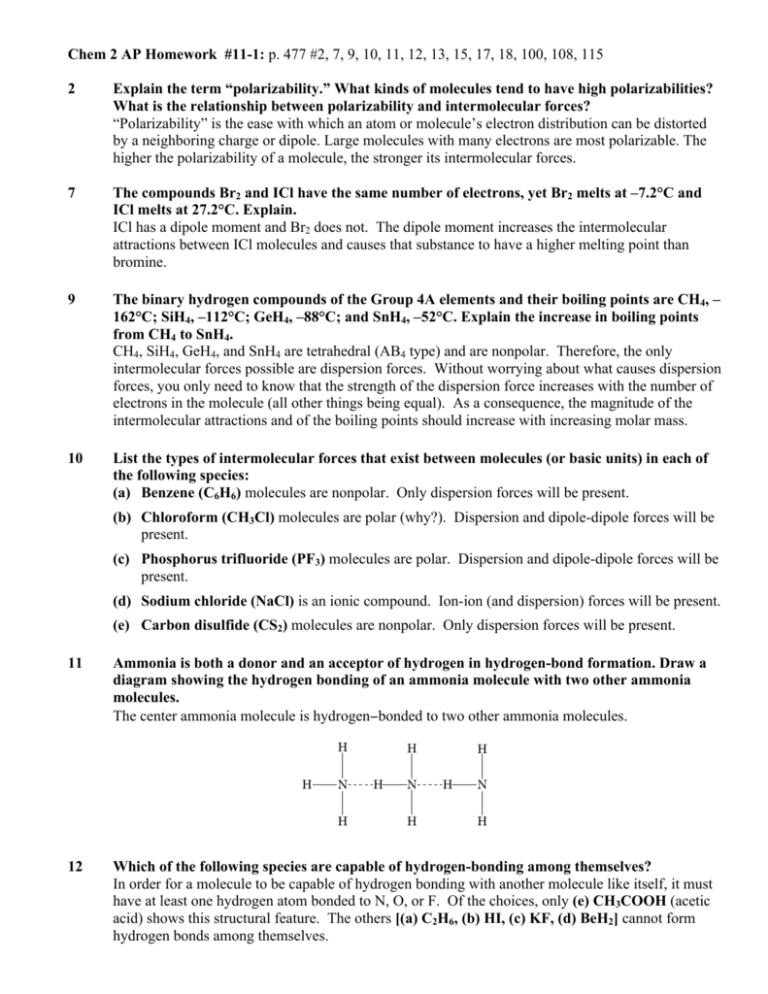
Chem 2 AP Homework #11-1: p. 477 #2, 7, 9, 10, 11, 12, 13, 15, 17, 18, 100, 108, 115 2 Explain the term “polarizability.” What kinds of molecules tend to have high polarizabilities? What is the relationship between polarizability and intermolecular forces? “Polarizability” is the ease with which an atom or molecule’s electron distribution can be distorted by a neighboring charge or dipole. Large molecules with many electrons are most polarizable. The higher the polarizability of a molecule, the stronger its intermolecular forces. 7 The compounds Br2 and ICl have the same number of electrons, yet Br2 melts at –7.2°C and ICl melts at 27.2°C. Explain. ICl has a dipole moment and Br2 does not. The dipole moment increases the intermolecular attractions between ICl molecules and causes that substance to have a higher melting point than bromine. 9 The binary hydrogen compounds of the Group 4A elements and their boiling points are CH4, – 162°C; SiH4, –112°C; GeH4, –88°C; and SnH4, –52°C. Explain the increase in boiling points from CH4 to SnH4. CH4, SiH4, GeH4, and SnH4 are tetrahedral (AB4 type) and are nonpolar. Therefore, the only intermolecular forces possible are dispersion forces. Without worrying about what causes dispersion forces, you only need to know that the strength of the dispersion force increases with the number of electrons in the molecule (all other things being equal). As a consequence, the magnitude of the intermolecular attractions and of the boiling points should increase with increasing molar mass. 10 List the types of intermolecular forces that exist between molecules (or basic units) in each of the following species: (a) Benzene (C6H6) molecules are nonpolar. Only dispersion forces will be present. (b) Chloroform (CH3Cl) molecules are polar (why?). Dispersion and dipole-dipole forces will be present. (c) Phosphorus trifluoride (PF3) molecules are polar. Dispersion and dipole-dipole forces will be present. (d) Sodium chloride (NaCl) is an ionic compound. Ion-ion (and dispersion) forces will be present. (e) Carbon disulfide (CS2) molecules are nonpolar. Only dispersion forces will be present. 11 Ammonia is both a donor and an acceptor of hydrogen in hydrogen-bond formation. Draw a diagram showing the hydrogen bonding of an ammonia molecule with two other ammonia molecules. The center ammonia molecule is hydrogen−bonded to two other ammonia molecules. H H N H 12 H H N H H H N H Which of the following species are capable of hydrogen-bonding among themselves? In order for a molecule to be capable of hydrogen bonding with another molecule like itself, it must have at least one hydrogen atom bonded to N, O, or F. Of the choices, only (e) CH3COOH (acetic acid) shows this structural feature. The others [(a) C2H6, (b) HI, (c) KF, (d) BeH2] cannot form hydrogen bonds among themselves. 2 HOMEWORK #1-2 ANSWER KEY 13 Arrange the following in order of increasing boiling point: Arranged in order of increasing boiling point: CO2, CH3Br, CH3OH, RbF. (1) CO2 is a nonpolar molecular compound. The only intermolecular force present is a relatively weak dispersion force (small molar mass). CO2 will have the lowest boiling point. (2) CH3Br is a polar molecule. Dispersion forces (present in all matter) and dipole−dipole forces will be present. This compound has the next highest boiling point. (3) CH3OH is polar and can form hydrogen bonds, which are especially strong dipole-dipole attractions. Dispersion forces and hydrogen bonding are present to give this substance the next highest boiling point. (4) RbF is an ionic compound (Why?). Ion−ion attractions are much stronger than any intermolecular force. RbF has the highest boiling point. 15 Which member of each of the following pairs of substances would you expect to have a higher boiling point? (a) O2 and Cl2: Cl2: it has more electrons the O2 (both are nonpolar) and therefore has stronger dispersion forces. (b) SO2 and CO2: SO2: it is polar (most important) and also has more electrons than CO2 (nonpolar). More electrons imply stronger dispersion forces. (c) HF and HI: HF: although HI has more electrons and should therefore exert stronger dispersion forces, HF is capable of hydrogen bonding and HI is not. Hydrogen bonding is the stronger attractive force. 17 Explain in terms of intermolecular forces why: (a) NH3 has a higher boiling point than CH4: CH4 has a lower boiling point because NH3 is polar and can form hydrogen bonds; CH4 is nonpolar and can only form weak attractions through dispersion forces. (b) KCl has a higher melting point than I2: KCl is an ionic compound. Ion−Ion forces are much stronger than any intermolecular forces. I2 is a nonpolar molecular substance; only weak dispersion forces are possible. 18 What kind of attractive forces must be overcome in order to (a) melt ice; (b) boil molecular bromine; (c) melt solid iodine; and (d) dissociate F2 into F atoms? (a) Water has O−H bonds. Therefore, water molecules can form hydrogen bonds. The attractive forces that must be overcome are hydrogen bonding and dispersion forces. (b) Bromine (Br2) molecules are nonpolar. Only dispersion forces must be overcome. (c) Iodine (I2) molecules are nonpolar. Only dispersion forces must be overcome. (d) In this case, the F−F bond must be broken. This is an intramolecular force between two F atoms, not an intermolecular force between F2 molecules. The attractive forces of the covalent bond must be overcome. 100 Which of the following substance has the highest polarizability? CH4, H2, CCl4, SF6, H2S. CCl4. Generally, the larger the number of electrons and the more diffuse the electron cloud in an atom or a molecule, the greater its polarizability. Recall that polarizability is the ease with which the electron distribution in an atom or molecule can be distorted. CCl4 has 72 electrons, while its closest competitor, SF6, only has 70. HOMEWORK #11-1 ANSWER KEY 108 3 Which of the following statements are false? (a) Dipole-Dipole interactions between molecules are greatest if the molecules possess only temporary dipole moments. False. Permanent dipoles are usually much stronger than temporary dipoles. (b) All compounds containing hydrogen atoms can participate in hydrogen-bond formation. False. The hydrogen atom must be bonded to N, O, or F. (c) Dispersion forces exist between all atoms, molecules, and ions. True. (d) The extent of ion-induced dipole interaction depends only on the charge on the ion. False. The magnitude of the attraction depends on both the ion charge and the polarizability of the neutral atom or molecule. 115 The fluorides of the second-period elements and their melting points are: LiF, 845°C; BeF2, 800°C; BF3, –126.7°C; CF4, –184°C; NF3, –206.6°C, OF2, –223.8°C; F2, –206.6°C. Classify the type(s) of intermolecular forces present in each compound. LiF, ionic bonding and dispersion forces; BeF2, ionic bonding and dispersion forces; BF3, dispersion forces; CF4, dispersion forces; NF3, dipole-dipole interaction and dispersion forces; OF2, dipoledipole interaction and dispersion forces; F2, dispersion forces.
